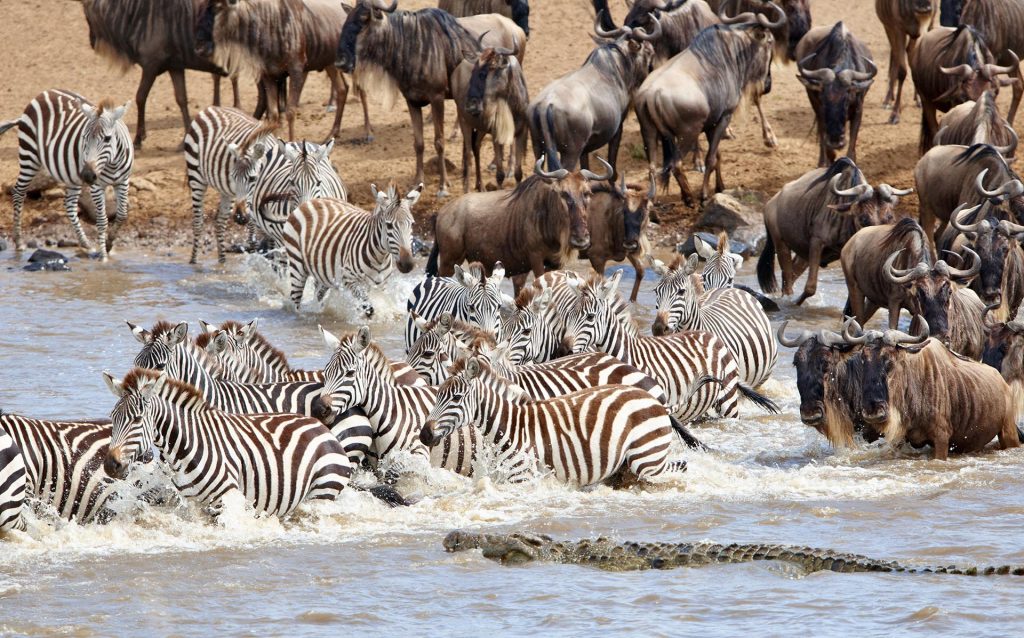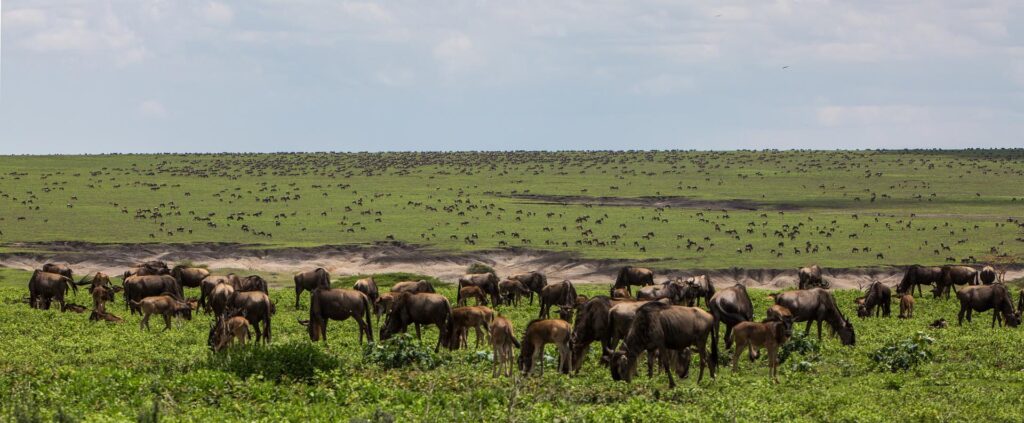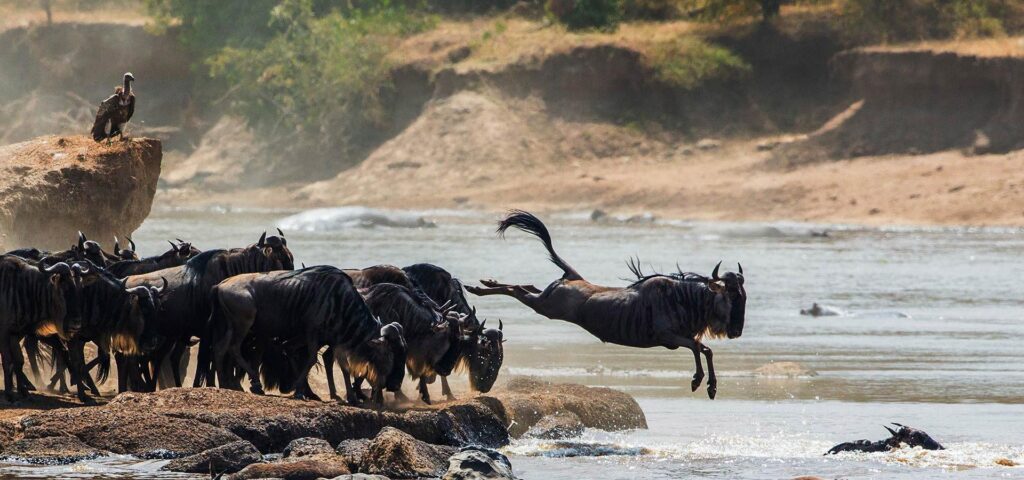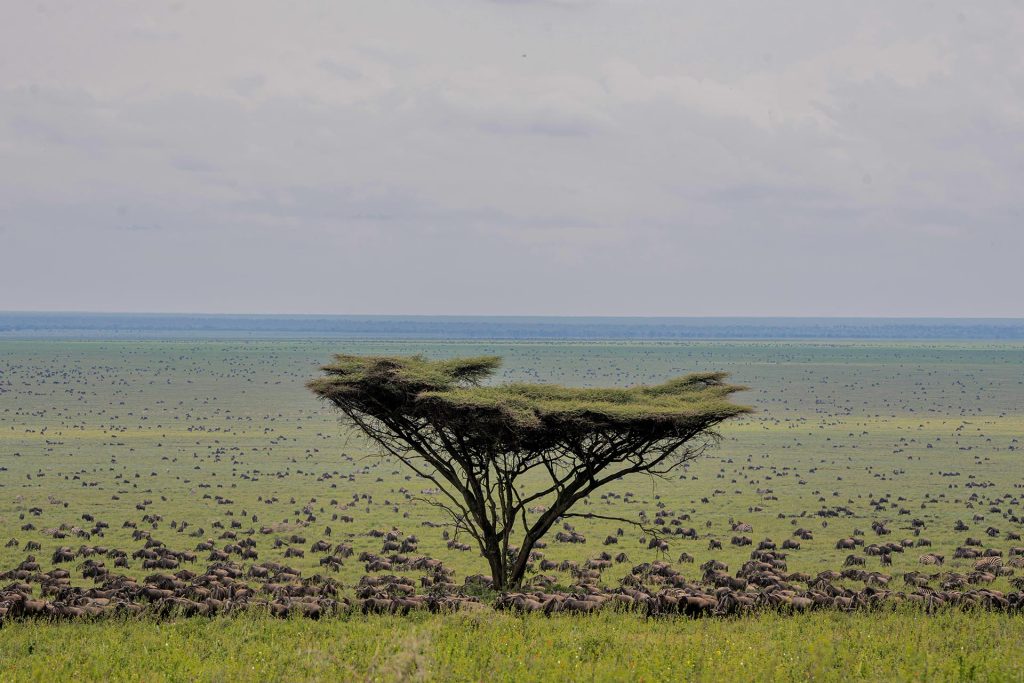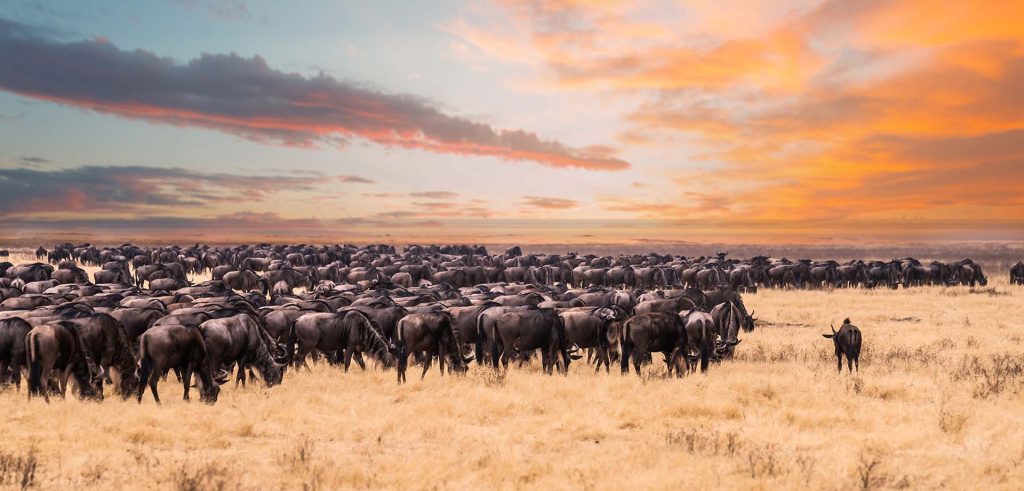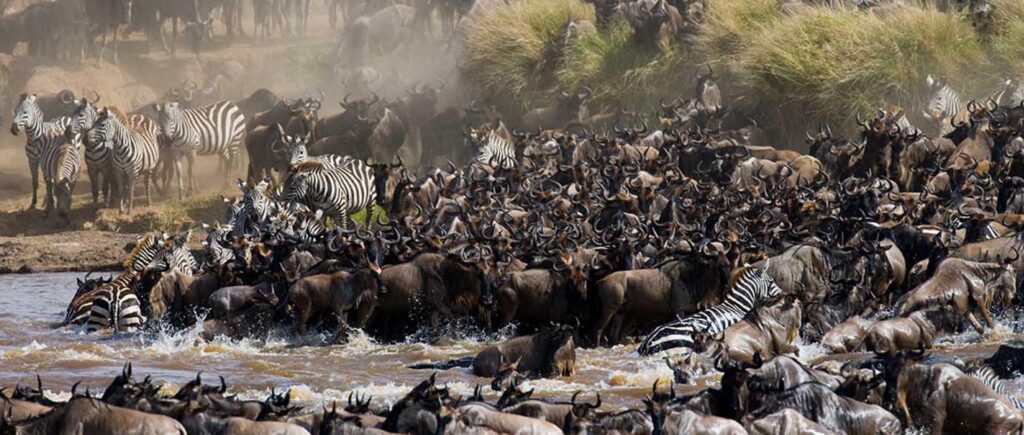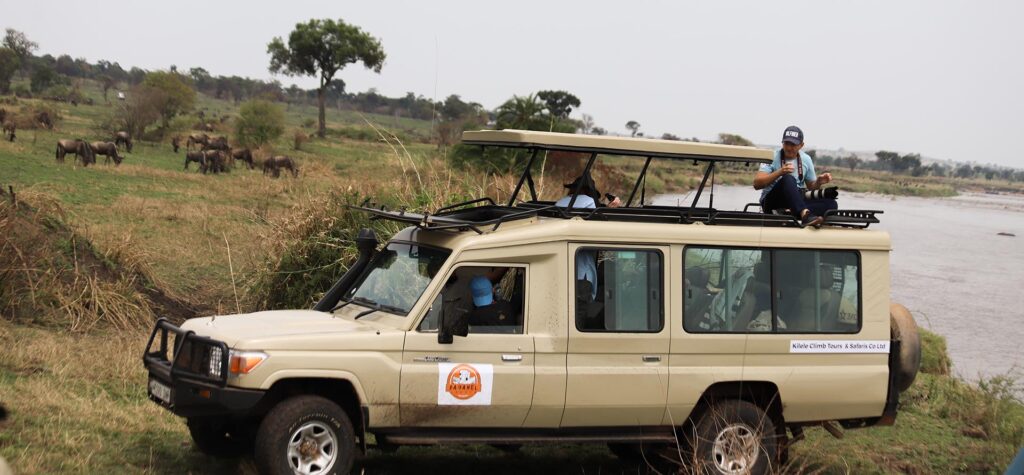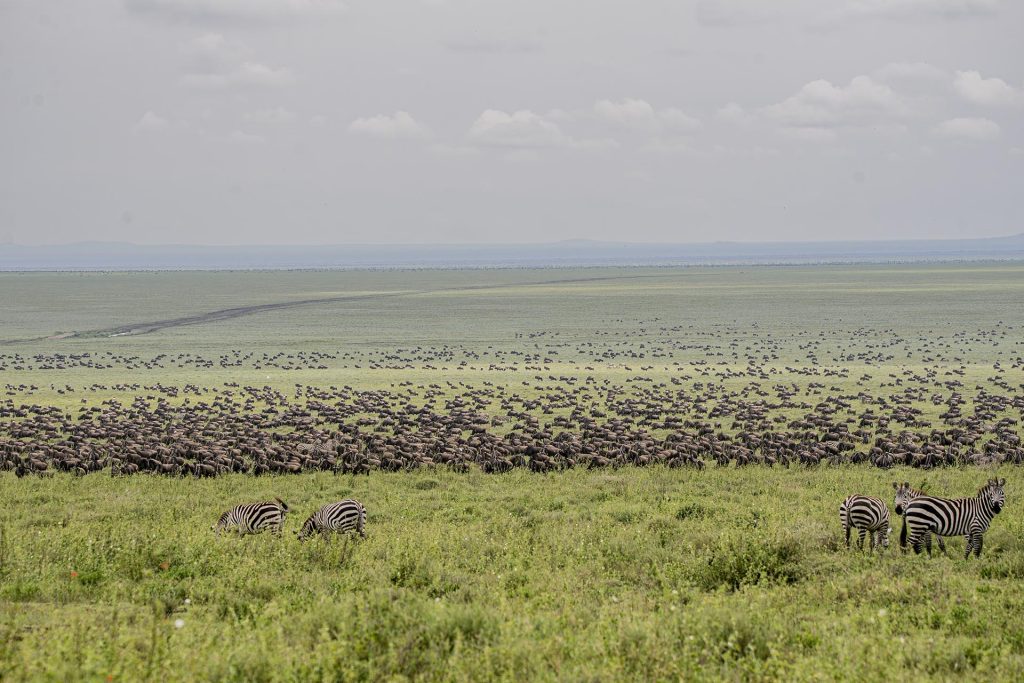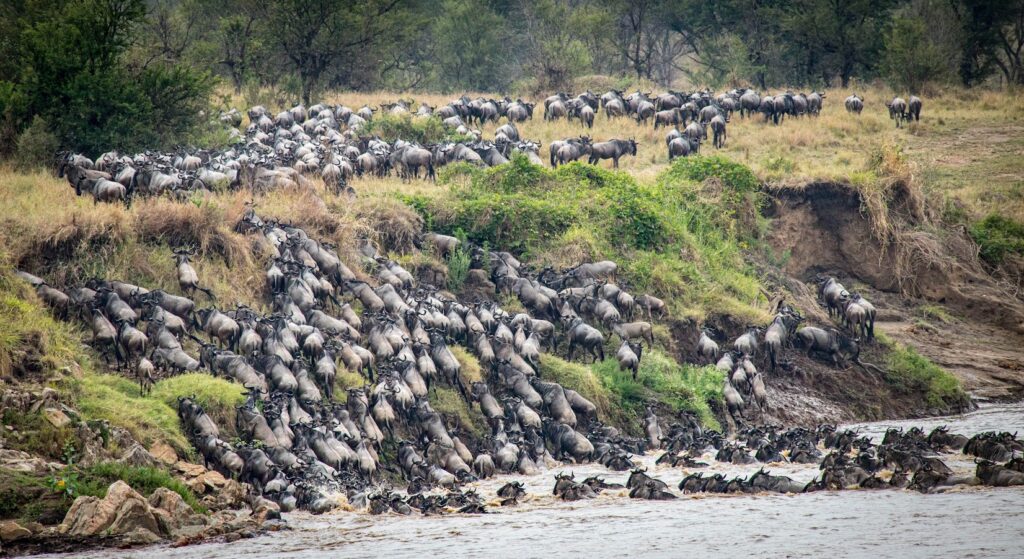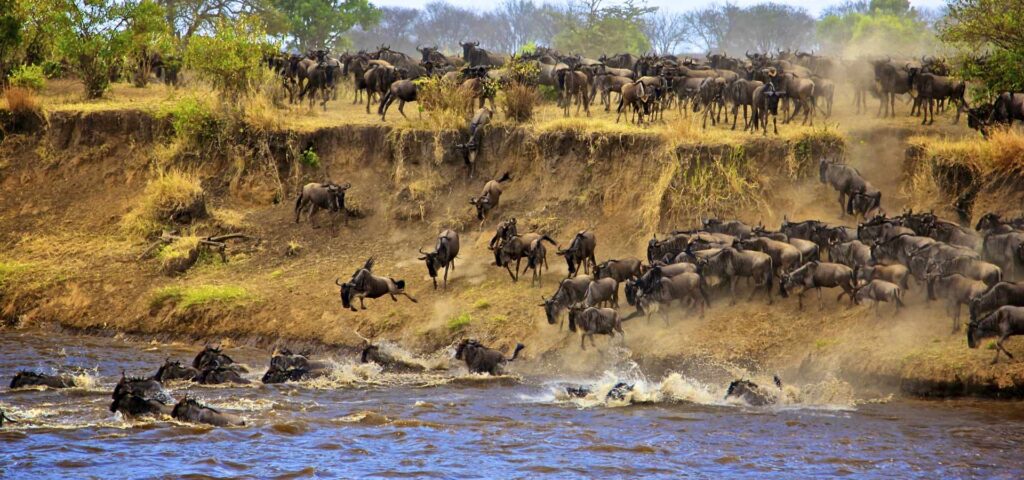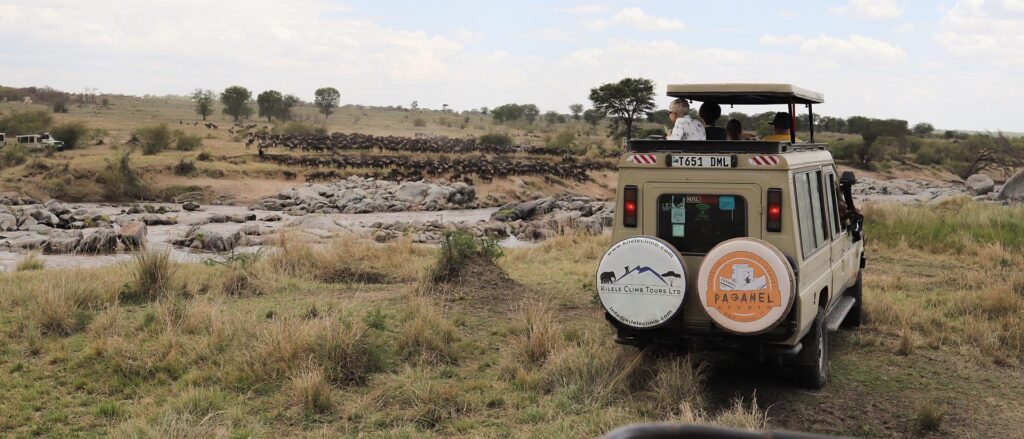Wildebeest Migration Safari
The Great Migration is an annual event, an endless march of life, birth, and death for millions of animals.
The Great Migration is a remarkable annual event, characterized by an endless march of life, birth, and death for millions of animals. It is known as one of the Seven Wonders of the Natural World. Every year, nearly two million wildebeest, zebras, and other antelopes gather their young and embark on a journey from Tanzania’s Southern Serengeti ecosystem to Kenya’s Maasai Mara game Reserve, where they search for greener pastures following the rainfall. The Great Migration is a unique occurrence because no other migration features such a high number of wildlife, except perhaps butterflies and smaller birds.
The wildebeest migration is a clockwise circle that spans two countries and covers a distance of 1800 miles/2800 kilometres in search of greener pastures. The migration is a crucial part of the wildebeests’ biological cycle, as it is during this period that they mate and give birth. The wildebeest’s mate in the Maasai Mara and then journey to the South Serengeti or the Ndutu Conservation Area, which borders the Ngorongoro and Serengeti, to give birth.
Predators such as lions, leopards, cheetahs, hyenas, and wild dogs follow the herds in anticipation of easy kills, offering excellent opportunities to catch these hunters in action. The river crossing is particularly filled with peril as herds gather in the thousands to ford the Grumeti and Mara rivers, with strong currents and lurking crocodiles lying in wait. Viewing kills and hordes of panicking animals may be stressful to some but offers extremely dramatic encounters and photographic opportunities.
The migration, either in its entirety or in smaller groups, can be seen in Tanzania during all times of the year
Let’s Start Planning Your Wildebeest Migration Safari
If you’re planning to go on just one African safari in your lifetime, it would have to be the Wildebeest Migration safari! Often dubbed as “The Greatest Wildlife Show on Earth”, it is a definite must-see for lovers of wildlife & nature.
Our safaris are designed to cover all major safari destinations in Tanzania. A specifically designed safari itinerary that features Tanzania Northern Parks, best suitable for wildebeest migration, big cats and visiting some unique sightings such as the largest crater in the world, Ngorongoro Crater.
7 Tips for Planning Your Wildebeest Migration Safari
Now let’s look at some of the best tips that you will need to know before planning your wildebeest migration safaris to Tanzania. These tips will help you plan accordingly, when and where to see the Great Migration, the best Camps and Lodges, the best time to book, and more about the wildebeest movement and how they migrate from Southern Serengeti, Ndutu Area to Northern Serengeti, Kogatende Region.
- When is the Best Time to Go on a Migration Safari?
Now that you know how the Great Wildebeest Migration in Africa works, you can easily see that the best time to go depends entirely on which events you’re personally interested in seeing. Remember, the Serengeti and Masai Mara’s abundance of wildlife and wide-open landscapes make them fantastic year-round safari destinations.
Event | Approximate Time | Place |
Calving Season | February to March | Southern Serengeti (Ndutu Area) |
Rutting Season | April to May | Western & Central Serengeti |
Grumeti River Crossing | May to June | Central Serengeti |
Mara River Crossing | July to October | Northern Serengeti (Kogatende Region) |
On the Move | November to January | Northern Serengeti to Southern Serengeti |
- Can the Migration River Crossing be Predicted?
No! As mentioned above, before you go on a Wildebeest migration safari, it’s important to understand that the exact timing of the animals’ movement is difficult to predict. As it’s a dynamic and ever-changing event, many travelers that have observed this migration more than once would agree that no two years unravel the same way.
Not even the wildebeest know when they’re going to cross! Some arrive at the water and swim over immediately; some arrive and spend days hanging around grazing; some arrive and turn back to where they came from. We wish we could predict the crossings, but no-one can. This is why it is best to have as much time on safari as possible if you hope to see a river crossing.
As the migration cycle takes a full year to complete, you can technically catch a glimpse of it throughout the year. However, since the animals migrate across a huge distance, some things that you may be hoping to see such as the mass birthing of calves or the river crossing occur only during specific months and regions.
- When to Planning and Make Enquiry
As you plan to witness the 7th wonder of the world in Tanzania, please note this is the loved and most witnessed wildlife event in Africa. Therefore, early planning is highly recommended in order to secure your holiday booking. We recommend starting planning and making inquiries in December to March of any year. This time frame between March and July helps you adjust and make minor amendments to the itinerary. Start planning your Serengeti Wildebeest Migration & Crossing Safaris.
- Book Dates and Number of Days
As you start to plan this expedition, you will ask yourself when is the best time for the wildebeest migration and crossings? Well, it’s not guaranteed of the dates to witness the wildebeest crossings to be specific. We recommend you book this safari between End of July and Mid October. To get the most out of the migration, it is recommended to spend a minimum of a week in your chosen region. This time will not only allow you to settle into the new environment but will also give you a good enough time to see the action without feeling jet-lagged and exhausted from travel.
- Accommodations – (Book Early-At least a Year in Advance)
Where you stay on your Wildebeest migration expeditions, do matter a lot. Some of the camps are more luxurious due to the prime location to witness the wildebeest crossings at a short distance. This helps you have maximum view and experience of this lifetime phenomenon. To have this chance, an early booking would be required to secure your booking, and have the best camps that will offer you maximum experience.
- Plan on other Safari activities:
It’s not only the wildebeest migration and crossings that will color your safari, but addons are best to compliment your whole experience in Tanzania. Adding other Optional Safari Activities will make your holiday more enjoyable. Engage in African safari walk, and walk along with other wildlife species, fly on a balloon safari and enjoy the migration from the sky, engage in cultural and community activities like visiting the Maasai communities, and learn their cultural lifestyle.
- What you would need to pack to best enjoy this spectacle.
Here is just a quick list of things to make sure you include when getting ready to experience the Great Wildebeest Migration:
- Binoculars: You might have 20 – 20 vision, but you probably won’t be close enough to see all the subtle yet exciting moments.
- A camera: This is a more obvious one. If you happen to spot a lion stalking its prey, this is a moment you’re definitely going to want to remember. If you carry a DSLR, a Tele lens and a wide-angle lens are a must for wildlife photography.
- Non-prescription medication: It is not fun to get sick while traveling. So, stay a step ahead of potential problems and pack pain relievers, antidiarrheals, antihistamines, and motion sickness pills.
- Sun Screen: Remember that, even though you’re chasing the rain, the African sun is harsh and being sunburned while on safari can really dampen the experience.
- Warm cloth to wear: One of the most common misconceptions is that when you’re traveling to Africa, it will always be hot. Sure, it is pretty hot over here and there are days where temperatures can reach up to 40C / 104F. But, in nature, there is always balance. The hotter days can often transform into icy nights, so it is important to pack a light jersey/jumper with you.
- Backpack: This is essential for storing all of your personal items. You want something that is lightweight and takes up minimal space as safari vehicles may have limited capacity for luggage.
Our Best Migration Safari Tours
We will gladly tailor-make your individual travel arrangements as per your wishes and ideas.
Our tour ideas are exactly that – sample itineraries to give you an idea of costs, flights, and how different destinations work together. All are completely customizable to your budget, timing, and preferences.

